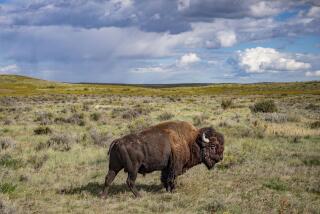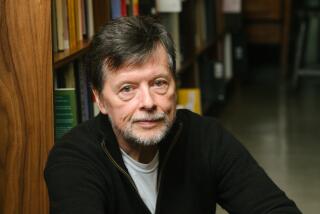Review: Ken Burns’ ‘The Dust Bowl’ a timely, exceptional endeavor
- Share via
Ken Burns, public television’s signature chronicler of great American moments, pastimes and inventions, has turned his Ken Burns Effect loose upon “The Dust Bowl.” One would say it was almost inevitable that two things so huge were bound to meet.
The four-hour film premieres Sunday and Monday on PBS and tells the story of the great drought that befell the Southern plains in the 1930s and the poor farming practices that made it into something far worse.
Though it has the pokey pace and flat affect of his other films — for Burns, history is elegy — it is also one of his best works: more tightly focused than usual in time and place, with a clear shape, dramatic arcs and a conclusion that is at once cautionary and moving, topical and timeless.
PHOTOS: Images from ‘The Dust Bowl’
It is also a kind of monster movie, which, like a lot of monster movies, begins with acts of overweening human ambition, heedlessness and greed: “It was the worst man-made disaster in American history,” says narrator Peter Coyote, bearing down on the words “man-made.” The conditions for catastrophe, centered in the Oklahoma panhandle and neighboring parts of Texas, New Mexico, Kansas and Colorado, were laid down in the conversion of a flat, windy, dry land, “almost wholly unfit for cultivation” in one early estimate, into a sea of wheat.
A number of wet years, plus the encouragements of the federal government, land speculators and bogus science, made all seem well for a while. But then the rain stopped, and the soil, already weakened by mechanical farming techniques — often for absentee “suitcase farmers” with no emotional attachment to the land — turned to dirt. Then the winds that formed the prairie gathered it up into black walls of dust, as much as 10,000 feet high and 200 miles wide, that rolled across the land, blotting out the sun, getting under doors and into the lungs, sometimes causing “dust pneumonia,” which could be fatal.
“We lived in a brown world.” says Dorothy Kleffman, of Guymon, Okla., one of two dozen Dust Bowl survivors Burns has interviewed. Most were children or teenagers in those years and they are as full of feeling as of fact as they recall dresses made from flour or feed sacks, the joy of precipitation (“we’d ... hold our hands up and let it hit our hand and our face and just almost worship that rain”) or the time one woman’s brother swallowed two dimes and “my mother made him use a slop jar to go to the bathroom until she dug those dimes out.”
PHOTOS: Celebrities by the Times
That’s because the story of the Dust Bowl is also a story of the Great Depression. Burns follows some of his subjects down Route 66 to California, the odyssey that gave John Steinbeck “The Grapes of Wrath,” but mostly sticks to the panhandle and the farmers who stuck it out: “next-year people,” hoping for the best and continually disappointed.
Burns lines up a lot of facts and films and some very fine photos — under the New Deal’s Farm Security Administration, hundreds of thousands of images were made by photographers including Walker Evans, Dorothea Lange and others. Dust Bowl balladeer Woody Guthrie comes on the scene at the close of Part 1 and sets the stage for Part 2, a welcome break from what seems like endless parlor renditions on the soundtrack of “Hard Times” and “Home on the Range.”
The film also has relevance to present-day arguments about our effect on the natural world and our responsibility to it, as well as the place of government in regulating these interactions. The people of the panhandle were not at first especially comfortable with the programs that helped keep them (and their livelihood) alive.
The Roosevelt administration itself was divided on whether to let it all go back to grassland or bring farmers to a better way of farming. In the end, they did both.
“People who think only in terms of the moment scoff at our efforts,” President Roosevelt said in a 1938 speech in Amarillo, Texas. That the scoffing goes on makes this bit of history feel urgent.
--
‘The Dust Bowl’
Where: KOCE
When: 8 and 10 p.m. Sunday and Monday
Rating: TV-PG (may be unsuitable for young children)
PHOTOS, VIDEOS & MORE:
Timeline: Emmy winners through the years
Celebrity meltdowns
VIDEO: Watch the latest fall TV trailers here
More to Read
The complete guide to home viewing
Get Screen Gab for everything about the TV shows and streaming movies everyone’s talking about.
You may occasionally receive promotional content from the Los Angeles Times.







